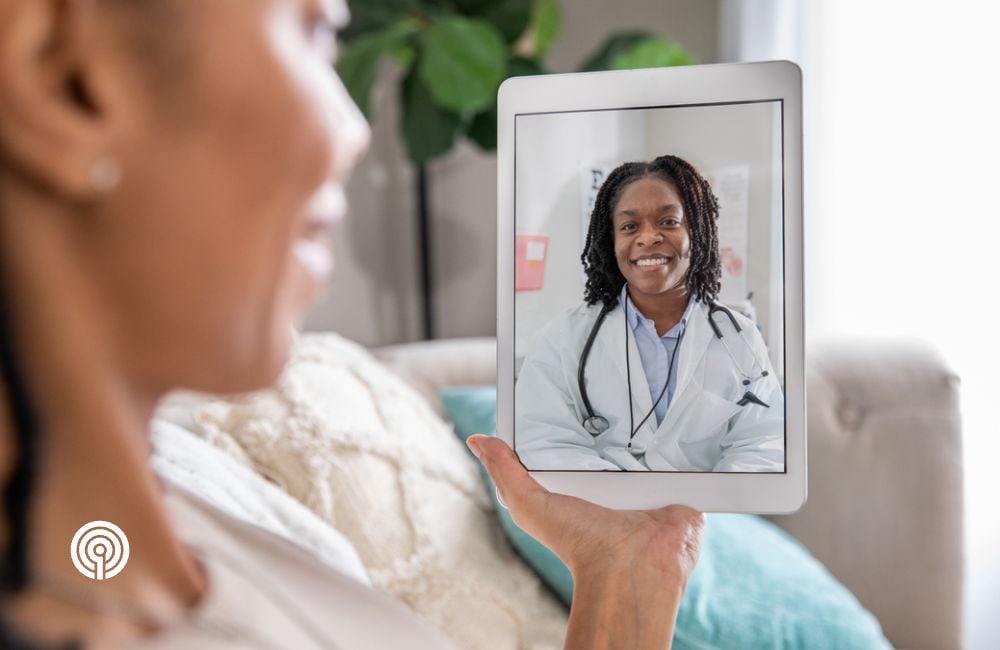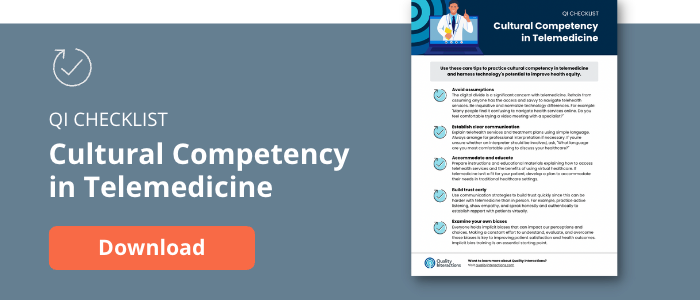
Telemedicine has the potential to reshape the delivery of healthcare and improve health equity. Just as with in-person interactions, cultural competency is an essential skill to ensure quality care. In fact, it is highly relevant to telemedicine, which has the power to either exacerbate or reduce healthcare disparities.
Download our 5-item checklist on Cultural Competency in Telemedicine.
What is telemedicine?
Virtual healthcare, also called telemedicine or telehealth, refers to using electronic communication technologies to facilitate remote clinical healthcare, patient education, and healthcare administration. Telemedicine is a growing movement that is beginning to influence the healthcare industry and patient experience. Long touted as an effective way to reach rural patients, telemedicine exploded into the mainstream at the beginning of the Covid-19 pandemic. The use of telemedicine peaked in April 2020, when 69% of doctor-patient visits were conducted virtually. While usage has fallen since then, approximately 26.7 million Americans used telemedicine in 2022, and 80% of doctors now provide telehealth services.
Telehealth technologies include:
- Live video conferencing - a live, two-way video conference between a patient and healthcare provider – this is still the most common telehealth modality and most similar to traditional clinical interactions
- Asynchronous telehealth (AKA "store and forward") - the transfer of clinical information to a healthcare provider (usually a specialist) for review and feedback at a later time
- Remote patient monitoring (RPM) - the collection of patient data in one location that is sent electronically to a healthcare professional for analysis (often used in senior living facilities)
- Mobile health (AKA mHealth) - the use of mobile health apps that collect and monitor data (such as blood sugar levels or water intake) and integrate with health records
Live video conferencing is the telehealth technology most relevant to the practice of cultural competency, and most of our tips and information about telemedicine refer to live video interactions between providers and patients.
Telemedicine and health disparities
The number of people using telemedicine rises with education and income levels. Studies have shown that older people, African Americans, Hispanic/Latinos, and non-English speakers are less likely to complete a telemedicine appointment via video. Telehealth could worsen existing health disparities due to a lack of smartphone ownership, a lack of a private space to conduct a telemedicine visit, data privacy concerns, or less technical knowledge.
However, there is also evidence that telemedicine reduces provider bias, which can contribute to healthcare disparities. An analysis of Covid-19 diagnoses in New York City shows that Black patients were correctly diagnosed with Covid more often via telemedicine than in person. The study suggests that the standardized experience provided by telemedicine might create a more even playing field where Black and white patients are treated the same.
One of the most significant promises of telemedicine is the ability to connect patients with providers of similar racial and ethnic backgrounds. Patients tend to be more satisfied with doctors of the same race and have better outcomes. Matching patients with limited English proficiency (LEP) with providers who are fluent in their native language could reduce health disparities based on language barriers.
Telemedicine's impact on health disparities could take years to analyze. What's clear now is that telemedicine can disrupt the healthcare industry and create positive change in provider access and real-time health monitoring. This is especially likely if supported by federal policies to expand broadband access and insurance reimbursement for telemedicine services.
The importance of telehealth cultural competency
Cultural competency fosters mutual respect and enhanced communication between providers and patients and improves healthcare delivery by tailoring services to meet patients' social, cultural, and linguistic needs. Telehealth cultural competency is essential to successful patient interactions, including virtual interactions.
A person-centered approach to cultural competency focuses on building cross-cultural communication skills that are adaptable to any situation. Cultural competency training gives healthcare providers the flexibility and perspective to meet their patients' individual needs.
Practicing cultural competency provides many benefits, including:
Health benefits:
- Increased preventative care
- Reduced missed appointments
- Reduced medical errors
- Reduced health disparities
Social benefits:
- Increased trust in the healthcare system
- Improved patient-provider communication
- More community involvement in health issues
Business benefits:
- Improved efficiency of care services
- Greater adherence to legal and regulatory guidelines
- More diverse perspectives in leadership
- Increased market share
How to practice telehealth cultural competency
Applying the principles of cultural competency to telemedicine helps ensure good communication, person-centered decision-making, and high-quality patient interactions in a virtual setting.
5 ways to practice telehealth cultural competency
-
Avoid assumptions
The digital divide is a significant concern with telemedicine. Refrain from assuming anyone has the access and savvy to navigate telehealth services. Be inquisitive and normalize technology differences. For example: "Many people find it confusing to navigate health services online. Do you feel comfortable trying a video meeting with a specialist?" -
Establish clear communication
Explain telehealth services and treatment plans using simple language. Always arrange for professional interpretation if necessary. If you're unsure whether an interpreter should be involved, ask, "What language are you most comfortable using to discuss your healthcare?"
-
Accommodate and educate
Prepare instructions and educational materials explaining how to access telehealth services and the benefits of using virtual healthcare. If telemedicine isn't a fit for your patient, develop a plan to accommodate their needs in traditional healthcare settings. -
Build trust early
Use communication strategies to build trust quickly since this can be harder with telemedicine than in person. For example, practice active listening, show empathy, and speak honestly and authentically to establish rapport with patients virtually. -
Be aware of your own biases
Everyone holds implicit biases that can impact our perceptions and choices. Making a constant effort to understand, evaluate, and overcome those biases is key to improving patient satisfaction and health outcomes. Implicit bias training is an essential starting point.
Cultural competency training resources
Cultural competency is a lifelong practice requiring ongoing training and support. Quality Interactions' peer-to-peer training based on actual clinical experience has helped over 500,000 healthcare professionals build skills and improve care.
Individual practitioners, enroll in online courses today and start practicing immediately.
Organizational leaders, request a demo to learn how to bring training to your entire staff to meet your budget and timeline.


